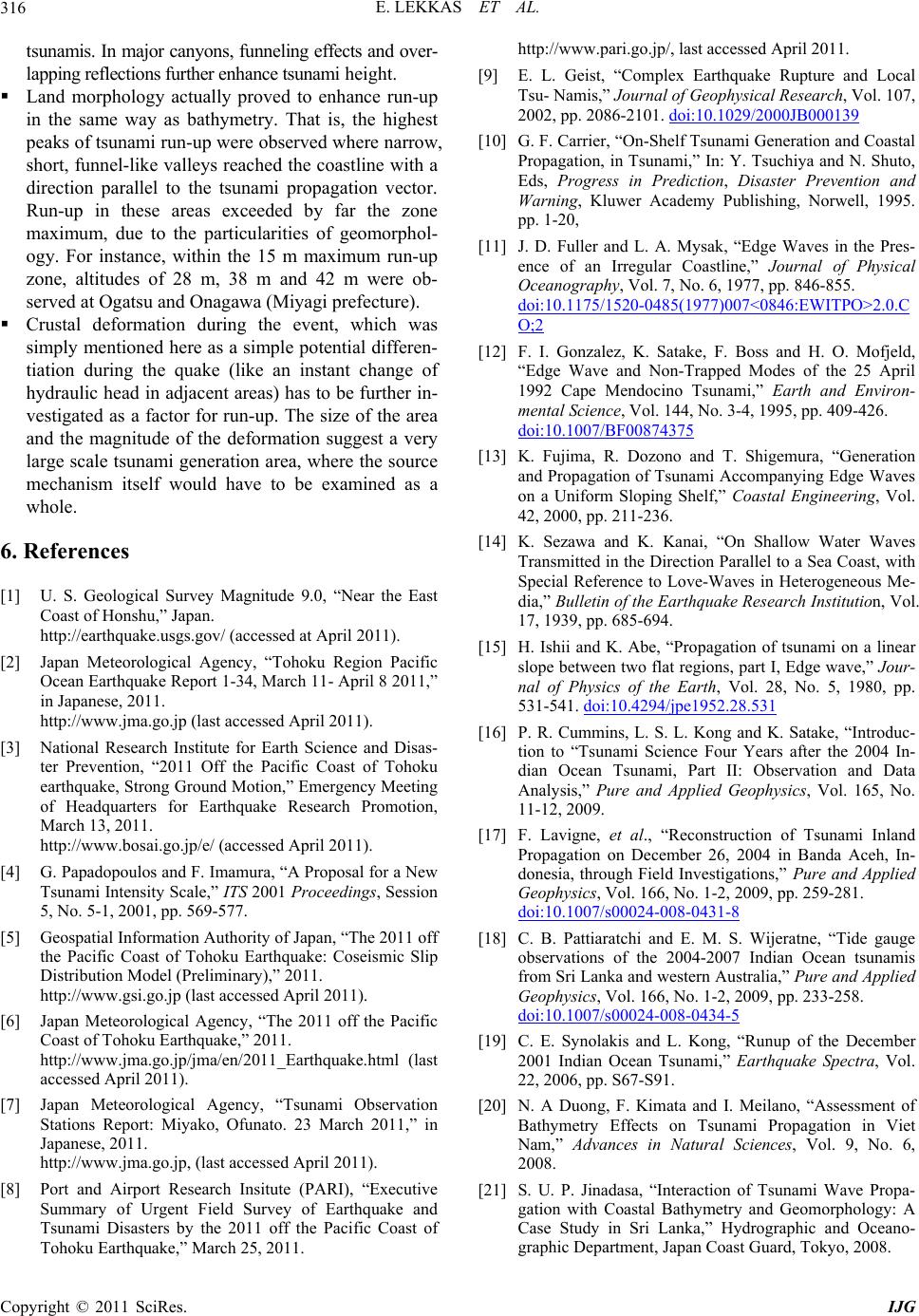
E. LEKKAS ET AL.
316
tsunamis. In major can yons, funneling effects and over-
lapping reflections further enhance tsunami height.
Land morphology actually proved to enhance run-up
in the same way as bathymetry. That is, the highest
peaks of tsunami run-up were observed where narrow,
short, funnel-like valleys reached the coastline with a
direction parallel to the tsunami propagation vector.
Run-up in these areas exceeded by far the zone
maximum, due to the particularities of geomorphol-
ogy. For instance, within the 15 m maximum run-up
zone, altitudes of 28 m, 38 m and 42 m were ob-
served at Ogatsu and Onagawa (Miyagi prefecture).
Crustal deformation during the event, which was
simply mentioned here as a si mple potential d ifferen-
tiation during the quake (like an instant change of
hydraulic head in adjacent areas) has to be further in-
vestigated as a factor for run-up. The size of the area
and the magnitude of the deformation suggest a very
large scale tsunami generation area, where the source
mechanism itself would have to be examined as a
whole.
6. References
[1] U. S. Geological Survey Magnitude 9.0, “Near the East
Coast of Honshu,” Japan.
http://earthquake.usgs.gov/ (accessed at April 2011).
[2] Japan Meteorological Agency, “Tohoku Region Pacific
Ocean Earthquake Report 1-34, March 11- April 8 2011,”
in Japanese, 2011.
http://www.jma.go.jp (last accessed April 2011).
[3] National Research Institute for Earth Science and Disas-
ter Prevention, “2011 Off the Pacific Coast of Tohoku
earthquake, Strong Ground Motion,” Emergency Meeting
of Headquarters for Earthquake Research Promotion,
March 13, 2011.
http://www.bosai.go.jp/e/ (accessed April 2011).
[4] G. Papadopoulos and F. Imamura, “A Proposal for a New
Tsunami Intensity Scale,” ITS 2001 Proceedings, Session
5, No. 5-1, 2001, pp. 569-577.
[5] Geospatial Information Authority of Japan, “The 2011 off
the Pacific Coast of Tohoku Earthquake: Coseismic Slip
Distribution Model (Preliminary),” 2011.
http://www.gsi.go.jp (last accessed April 2011).
[6] Japan Meteorological Agency, “The 2011 off the Pacific
Coast of Tohoku Earthquake,” 2011.
http://www.jma.go.jp/jma/en/2011_Earthquake.html (last
accessed April 2011).
[7] Japan Meteorological Agency, “Tsunami Observation
Stations Report: Miyako, Ofunato. 23 March 2011,” in
Japanese, 2011.
http://www.jma.go.jp, (last accessed April 2011).
[8] Port and Airport Research Insitute (PARI), “Executive
Summary of Urgent Field Survey of Earthquake and
Tsunami Disasters by the 2011 off the Pacific Coast of
Tohoku Earthquake,” March 25, 2011.
http://www.pari.go.jp/, last accessed April 2011.
[9] E. L. Geist, “Complex Earthquake Rupture and Local
Tsu- Namis,” Journal of Geophysical Research, Vol. 107,
2002, pp. 2086-2101. doi:10.1029/2000JB000139
[10] G. F. Carrier, “On-Shelf Tsunami Generation and Coastal
Propagation, in Tsunami,” In: Y. Tsuchiya and N. Shuto,
Eds, Progress in Prediction, Disaster Prevention and
Warning, Kluwer Academy Publishing, Norwell, 1995.
pp. 1-20,
[11] J. D. Fuller and L. A. Mysak, “Edge Waves in the Pres-
ence of an Irregular Coastline,” Journal of Physical
Oceanography, Vol. 7, No. 6, 1977, pp. 846-855.
doi:10.1175/1520-0485(1977)007<0846:EWITPO>2.0.C
O;2
[12] F. I. Gonzalez, K. Satake, F. Boss and H. O. Mofjeld,
“Edge Wave and Non-Trapped Modes of the 25 April
1992 Cape Mendocino Tsunami,” Earth and Environ-
mental Science, Vol. 144, No. 3-4, 1995, pp. 409-426.
doi:10.1007/BF00874375
[13] K. Fujima, R. Dozono and T. Shigemura, “Generation
and Propagation of Tsunami Accompanying Edge Waves
on a Uniform Sloping Shelf,” Coastal Engineering, Vol.
42, 2000, pp. 211-236.
[14] K. Sezawa and K. Kanai, “On Shallow Water Waves
Transmitted in the Direction Parallel to a Sea Coast, with
Special Reference to Love-Waves in Heterogeneous Me-
dia,” Bulletin of the Earthquake Research Institution, Vol.
17, 1939, pp. 685-694.
[15] H. Ishii and K. Abe, “Propagation of tsunami on a linear
slope between two flat regions, part I, Edge wave,” Jour-
nal of Physics of the Earth, Vol. 28, No. 5, 1980, pp.
531-541. doi:10.4294/jpe1952.28.531
[16] P. R. Cummins, L. S. L. Kong and K. Satake, “Introduc-
tion to “Tsunami Science Four Years after the 2004 In-
dian Ocean Tsunami, Part II: Observation and Data
Analysis,” Pure and Applied Geophysics, Vol. 165, No.
11-12, 2009.
[17] F. Lavigne, et al., “Reconstruction of Tsunami Inland
Propagation on December 26, 2004 in Banda Aceh, In-
donesia, through Field Investigations,” Pure and Applied
Geophysics, Vol. 166, No. 1-2, 2009, pp. 259-281.
doi:10.1007/s00024-008-0431-8
[18] C. B. Pattiaratchi and E. M. S. Wijeratne, “Tide gauge
observations of the 2004-2007 Indian Ocean tsunamis
from Sri Lanka and western Australia,” Pure and Applied
Geophysics, Vol. 166, No. 1-2, 2009, pp. 233-258.
doi:10.1007/s00024-008-0434-5
[19] C. E. Synolakis and L. Kong, “Runup of the December
2001 Indian Ocean Tsunami,” Earthquake Spectra, Vol.
22, 2006, pp. S67-S91.
[20] N. A Duong, F. Kimata and I. Meilano, “Assessment of
Bathymetry Effects on Tsunami Propagation in Viet
Nam,” Advances in Natural Sciences, Vol. 9, No. 6,
2008.
[21] S. U. P. Jinadasa, “Interaction of Tsunami Wave Propa-
gation with Coastal Bathymetry and Geomorphology: A
Case Study in Sri Lanka,” Hydrographic and Oceano-
graphic Department, Japan Coast Guard, Tokyo, 2008.
Copyright © 2011 SciRes. IJG